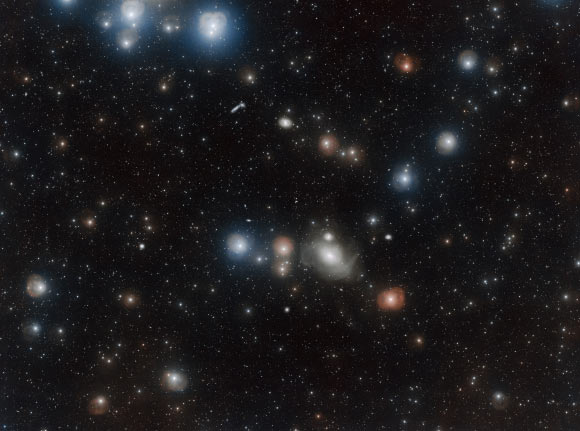One of the largest and most detailed images of the Fornax Cluster ever created has been released by the European Southern Observatory (ESO).

Countless galaxies vie for attention in this VST image of the Fornax Cluster (also known as ACO S 373 and MCL 52), some appearing only as pinpricks of light while others dominate the foreground. One of these is the lenticular galaxy NGC 1316. Image credit: A. Grado & L. Limatola, ESO.
At a distance of about 60 million light-years, the Fornax Cluster is one of the richest and closest galaxy clusters to our Milky Way Galaxy.
Galaxy clusters like this one are commonplace in the Universe and illustrate the powerful influence of gravity over large distances as it draws together the enormous masses of individual galaxies into one region.
The Fornax Cluster contains at least 60 large galaxies and a similar number of dwarf galaxies.
Perhaps the most fascinating member is the lenticular galaxy NGC 1316.
It has experienced a dynamic history, being formed by the merger of multiple smaller galaxies. The gravitational distortions of the galaxy’s adventurous past have left their mark on its structure.
Large ripples, loops and arcs embedded in NGC 1316’s starry outer envelope were first observed in the 1970s, and they remain an active field of study for contemporary astronomers, who use the latest telescope technology to observe the finer details of the galaxy’s unusual structure through a combination of imaging and modeling.
The mergers that formed NGC 1316 led to an influx of gas, which fuels an exotic astrophysical object at its center: a supermassive black hole with a mass roughly 150 million times that of the Sun.
As it accretes mass from its surroundings, this cosmic monster produces immensely powerful jets of high-energy particles, that in turn give rise to the characteristic lobes of emission seen at radio wavelengths, making NGC 1316 the fourth-brightest radio source in the sky.
This image was taken by the VLT Survey Telescope (VST) at ESO’s Paranal Observatory in Chile as part of the Fornax Deep Survey, a project to provide a deep, multi-imaging survey of the Fornax Cluster.







